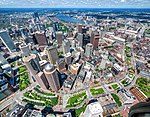O'Neill Tunnel

The Thomas P. "Tip" O'Neill Jr. Tunnel (colloquially O'Neill Tunnel) is a highway tunnel built as part of the Big Dig in Boston, Massachusetts. It carries the Central Artery underneath downtown Boston, and is numbered as Interstate 93 (I-93), U.S. Route 1 (US 1), and Route 3. It roughly follows the route of the old elevated Central Artery, though the northbound entrance, at the corner of Kneeland Street and Atlantic Avenue, is somewhat east of the southbound exit (at Kneeland and Albany streets) to allow for a reconfigured interchange with the Massachusetts Turnpike. It runs from the Zakim Bunker Hill Bridge at its north portal—barely 165 feet (50 m) east of the TD Garden sports facility's eastern corner—to Boston's Chinatown at its south portal. The tunnel is named for Tip O'Neill, former Speaker of the United States House of Representatives, whose constituency included several of the surrounding communities in Metro Boston.
Excerpt from the Wikipedia article O'Neill Tunnel (License: CC BY-SA 3.0, Authors, Images).O'Neill Tunnel
John F. Fitzgerald Expressway, Boston North End
Geographical coordinates (GPS) Address Nearby Places Show on map
Geographical coordinates (GPS)
| Latitude | Longitude |
|---|---|
| N 42.357777777778 ° | E -71.051666666667 ° |
Address
TE-425
John F. Fitzgerald Expressway
02110 Boston, North End
Massachusetts, United States
Open on Google Maps









